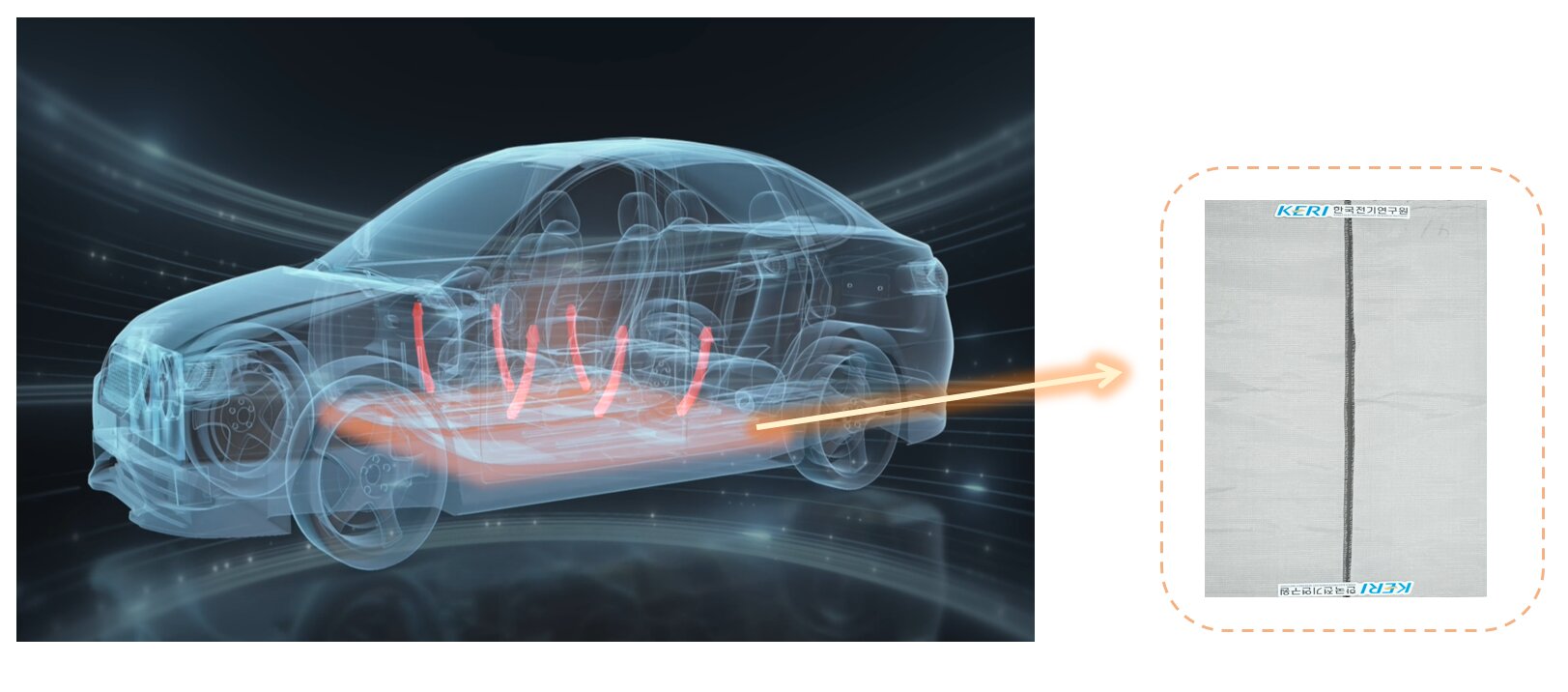
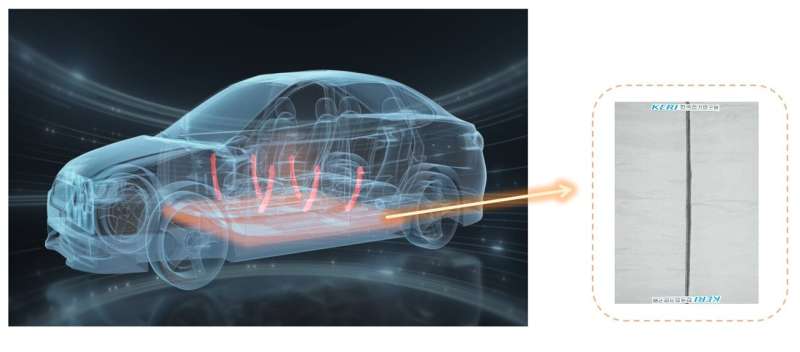
Dr. Lee Dong Yoon’s team at KERI’s Energy Conversion Research Center has developed a “plane heating element” made of metal fiber fabric technology, characterized by high efficiency and flexibility, to overcome the shortcomings of cold-sensitive electric vehicles (EV).
In winter, battery performance often decreases, and energy consumption for regulating the vehicle’s interior temperature increases, leading to a decline in the EV’s energy efficiency (driving range per kWh). The U.S. Environmental Protection Agency (EPA) has reported that in a sub-zero (7°C) environment, the EV’s energy efficiency drops by 34%, and the driving range is reduced by 57% compared to room temperature (24°C).
A key factor in improving electric vehicle performance is the thermal management system. ICE vehicles can use the waste heat from the engine as a heat source to control the interior temperature. However, electric vehicles lack sufficient waste heat, requiring separate systems like heaters, which often lead to reduced driving range. To overcome this limitation, many researchers are focusing on managing and utilizing the heat generated by EV’s electrical components to enhance energy efficiency.
Among these efforts, a leading domestic automotive group has introduced the radiant heat system, inspired by the traditional ondol (Korean underfloor heating system) method. This technology applies a plane heating element that generates heat by supplying power to the interior parts of the vehicle. It is considered a promising new technology that will significantly contribute to energy savings in electric vehicles.
Compared to conventional heating methods, this system reduces energy consumption required to reach an optimal temperature while maintaining heat retention for a longer period. Therefore, this technology has the potential to solve the issue of reduced driving range in electric vehicles during the winter season.
Currently, the Positive Temperature Coefficient Thermistor (PTC) is used as the heating element. PTC offers advantages such as fast heating, self-regulation to prevent overheating, compact size, and low noise. However, it is bulky, heavy, and consumes high power, making it challenging to apply in electric vehicles.
Due to these drawbacks, heating elements using wire or carbon heating sources are being proposed as alternatives to PTC. However, these alternatives still have limitations, such as low thermal efficiency or the risk of fire, and are not fully viable solutions.
To address these issues, Dr. Lee’s team at KERI has proposed the plane heating element made of metal fiber fabric technology, utilizing their expertise in developing fabric-based solar cells and heating clothing technologies. This technology begins with a loom that weaves warp and weft threads to create the fabric.
-
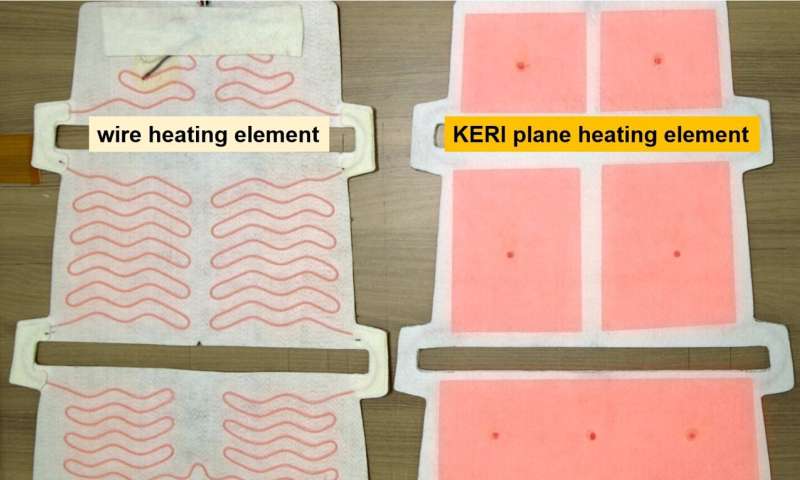
Metal fiber fabric applied to vehicle seats. KERI’s technology features a generating heat over a large area, offering high heating efficiency. Even if a break or partial damage occurs, the performance is maintained. Credit: Korea Electrotechnology Research Institute
-
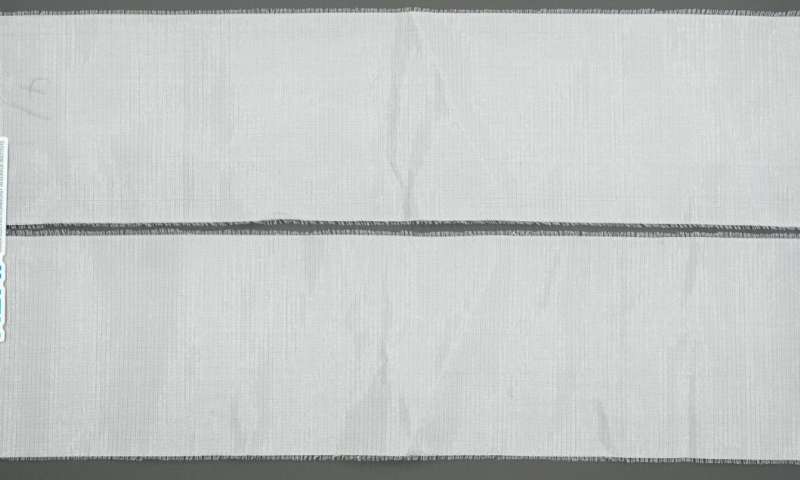
KERI’s high-efficiency, highly flexible ‘plane heating element made of metal fiber fabric’ can be applied to various interior components of electric vehicles, enabling ondol-style heating during the winter. Credit: Korea Electrotechnology Research Institute
The fabric was created by weaving extremely thin stainless steel micro wires (SUS316L) with a diameter of 50μm (less than half the thickness of a human hair), which boasts high thermal conductivity and durability. This fabric was then applied as a heating element, with additional detailed technologies such as insulation layers and electrode configurations integrated. When electricity flows through the fabric, it heats up to a maximum of 500°C due to the internal resistance of the metal.
Since the metal fiber fabric generates heat over a large area in surface form, and does not generate heat locally like a line, it provides uniform temperature distribution in heating applications and is highly flexible, allowing it to be easily attached to curved surfaces inside the vehicle interior parts.
Additionally, when the same amount of electricity is passed through the heating element, the metal fiber fabric shows 10–30% higher heating performance compared to traditional wire heating elements, making it highly efficient. Most importantly, due to the fabric’s characteristics, even if a break or partial damage occurs during use, the performance is maintained, and it continues to heat reliably, which is its greatest strength.
-
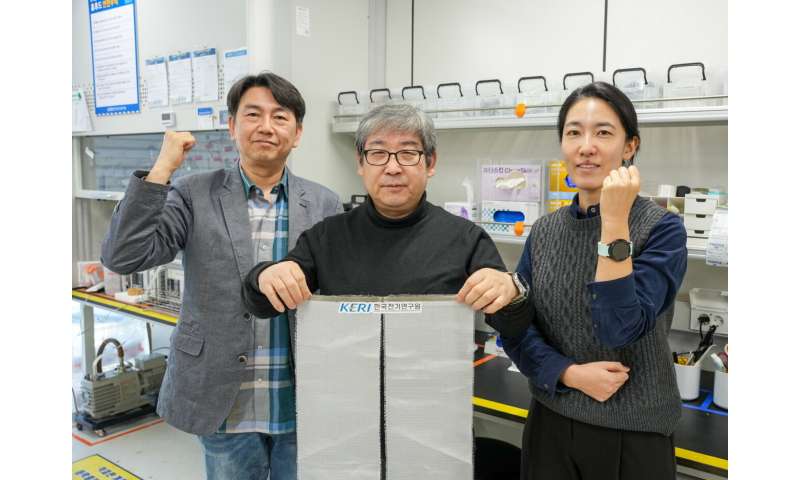
KERI Dr. Lee Dong Yoon’s team (pictured in the center) has developed the ‘plane heating element made of metal fiber fabric’ technology, characterized by high efficiency and flexibility, to realize ondol-style heating for electric vehicles in the winter. Credit: Korea Electrotechnology Research Institute
-
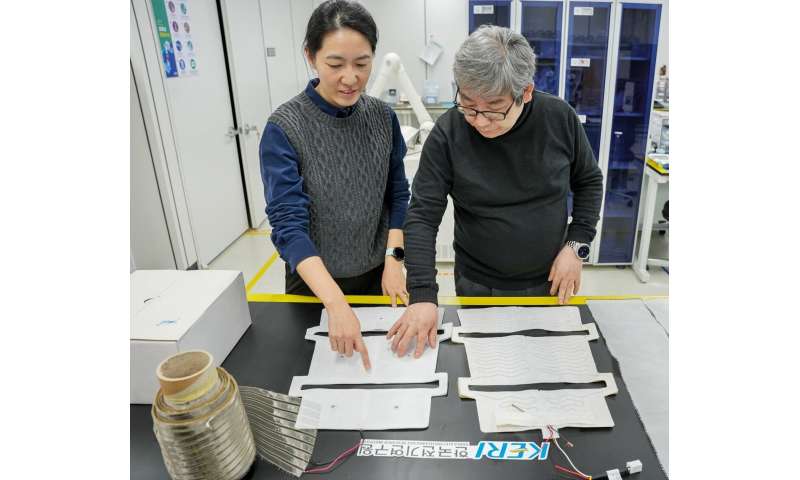
KERI Dr. Lee Dong Yoon’s team has developed the ‘plane heating element made of metal fiber fabric’ technology, featuring high efficiency and flexibility, to realize ondol-style heating for electric vehicles in the winter. Credit: Korea Electrotechnology Research Institute
With these many advantages, KERI’s plane heating element made of metal fiber fabric is regarded as the ideal technology for implementing ondol-style floor heating in electric vehicles. Unlike air-based heating systems that can dry out the interior over long periods, this technology uses radiant heat, which warms large areas and provides a more comfortable environment.
Moreover, this technology is a versatile solution applicable to various industries that require uniform heat distribution, including manufacturing (semiconductor production equipment, chemical plant piping, mechanical heating devices), consumer products (massage chairs, electric blankets, leisure heating devices), medical, and military applications. Its potential is limitless. The research team believes that companies in these sectors can achieve 10–30% energy savings by utilizing the plane heating element made of metal fiber fabric.
Dr. Lee stated, “Metal fibers are much stiffer than threads, making weaving extremely difficult. However, after long efforts and collaborating with Song I Textile Co., Ltd., a fabric production and processing company, we were able to develop a dedicated weaving machine and weaving pattern for metal fibers.
“This is the first time in the world that a fabric-based heating element has been made solely from metal fibers, and through our achievements, we expect to help companies reduce energy costs and contribute to national carbon neutrality.”
KERI, which has completed the patent application, has successfully passed the standardization tests for the plane heating element made of metal fiber fabric with a leading domestic semiconductor conglomerate, completing performance verification. Currently, five technology transfers have been completed, and the goal is to identify companies with demand related to technologies in sectors such as electric vehicles and semiconductors to promote prototype development and further technology transfers.
Citation:
Fabric woven with metal fibers can keep cold-sensitive electric vehicles warm (2025, January 14)
retrieved 14 January 2025
from https://techxplore.com/news/2025-01-fabric-woven-metal-fibers-cold.html
This document is subject to copyright. Apart from any fair dealing for the purpose of private study or research, no
part may be reproduced without the written permission. The content is provided for information purposes only.



